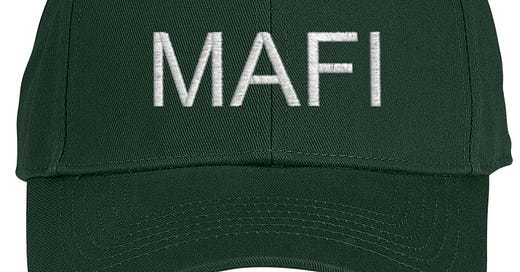Hyperinflation starting? Money printing never has a good outcome.
The federal government--and the Federal Reserve--have been destabilizing the economy for decades. Men and women entrepreneurs are keeping the economy humming.
Perry Atkinson and I recently discussed the unfolding economic events.
Commemorating Memorial Day is a bittersweet event. Having walked through the American cemetery on Normandy Beach a few years ago, I could not help thinking about the young men whose lives were ended and those who were maimed for life because of the decisions by a handful of politicians. Everyone deserves to live out their lives in peace. Rest in peace America’s soldiers.
MAKE AMERICANS FINANCIALLY INDEPENDENT
In 1974 I was a full time doctoral student at Rutgers University and decided to write a dissertation on inflation, which hit double digits that year. The economy was reeling from the “oil shock,” and in August President Nixon resigned after more revelations about the Watergate coverup. The Federal Reserve’s easy money policies two years earlier sparked the spiral in prices and wages after price controls (August 15, 1971) were lifted.
The inspiration for my dissertation topic was a passage in Murray Rothbard’s economic treatise, Man, Economy, and State. Rothbard points out that new money enters the economy at a point or points (typically the banking system) and then “diffuses” throughout the country. Eureka. In other words, there is “geographic” component of inflation, namely, new money is not equally “distributed” and thus prices would tend to rise at varying rates as the new money is spent according to people’s preferences.
In April 1974 I invited Rothbard to be a member of my dissertation committee and he enthusiastically accepted. I am eternally grateful for his encouragement and guidance in writing my dissertation, The Spatial Incidence of Inflation: An Economic Geographical Perspective, 1967-1971.
My dissertation was written in the Geography Department, and to get up to speed about the effects of monetary inflation on local economies I immersed myself in studying numerous case studies of inflation and episodes of hyperinflation. One economist defined hyperinflation as prices increasing by at least 50% per month. The Confederacy experienced hyperinflation during the Civil War.
In 1974, the US economy did not come close to that threshold and the double digit inflation in the late 1970s and early 1980s did not reach that level either.
Nevertheless, after decades of Federal Reserve “money printing” the copper and now copper and zinc penny will be deep-sixed because it costs nearly 4 cents to produce a one cent penny. The five cent nickel costs 13.8 cents to produce, and probably will be on the chopping block soon as well.
The moral of the story of money in the US and around the world, government issued paper currency declines in value, while coins minted in metals increase in value.
Several years ago I bought nickels at our local bank in Fort Lee when I read it cost 8 or 9 cents to produce a nickel. I bought a few dollars worth of nickels. But the assets—real money—to hold over time because of the Fed’s money printing are gold and silver.
Decide for yourself if you have not purchased any protection against the possibility of another episode of double digit inflation how much precious metal you want to have in your portfolio. There is no one “size fits all” suggestion. One general rule that some financial advisors recommend is at least 5 percent of your portfolio should be in precious metals. See this week’s Barron’s about portfolio allocation.
Hyperinflation can begin very slowly. First, prices rise slowly, like now, then “gallop” to low double digit rates, like the 1970s, and then runaway like Weimar Germany in the 1920s, China after World War II, and in Argentina and other South American countries throughout the 20th century. Other nations have experienced hyperinflation too.
The bottom line: Central banks are the engines of inflation. We need to separate money from an arm of the government.
*************************************************************************************************************
James Bovard on protectionism.
Recent interviews discussing the state of the economy with Perry Atkinson, Jim Peters, and Randy Durham.
********************************************************************************************
Dave Campbell and I discuss MAFI on the Clarity and Chaos podcast.
Col. Mike and Dr. Mike and I discuss Trump and his promises on the National Security Hour.
*********************************************************************************************************
Restoring free enterprise, medical freedom, and a constitutional federal budget.
The insufferable Jim Cramer reveals his economic ignorance in a recent CNBC rant.
*********************************************************************************************
Tom DiLorenzo’s pamphlet, Axis of Evil, is now available at the Mises Institute.
Order a free copy of Rothbard’s money and banking classic monograph. Or, you can read it online here.
My December 10 talk on medical care.
Bob Murphy interviews Dr. Keith Smith of the Surgery Center of OK.
****************************************************************
Murray Sabrin, PhD, is emeritus professor of finance, Ramapo College of New Jersey. Dr. Sabrin is considered a “public intellectual” for writing about the economy in scholarly and popular publications. His book, The Finance of Health Care: Wellness and Innovative Approaches to Employee Medical Insurance (Business Expert Press, Oct. 24, 2022), and his other BEP publication, Navigating the Boom/Bust Cycle: An Entrepreneur’s Survival Guide (October 2021), provides decision makers with tools needed to help manage their businesses during the business cycle. Sabrin's autobiography, From Immigrant to Public Intellectual: An American Story, was published in November, 2022. He is also the author of Why the Federal Reserve Sucks.




Since the deficits are going to keep piling up into eternity, someone has to invent the money to pay for more nonsense.